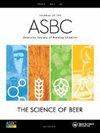Optimization and Kinetic Modeling of Honey Fermentation for Laboratory and Pilot-Scale Mead Production
IF 1.8
4区 农林科学
Q4 BIOTECHNOLOGY & APPLIED MICROBIOLOGY
Journal of the American Society of Brewing Chemists
Pub Date : 2021-09-14
DOI:10.1080/03610470.2021.1966590
引用次数: 2
Abstract
Abstract Honey is usually employed for the elaboration of mead, an alcoholic beverage obtained through fermentation with yeast. However, its production in many places is incipient and still has such drawbacks as long process times, undesired fermentation, and sensory quality problems. In this research, a three-level factorial design was used to evaluate the effect of the initial honey monosaccharide concentration (glucose and fructose) and yeast assimilable nitrogen content on the alcoholic fermentation yield at a laboratory scale. Fermentation tests were conducted at 25 °C for 20 days using Saccharomyces cerevisiae subsp. bayanus and bee-pollen as a nutrient source. Residual sugars, assimilable nitrogen, glycerol, ethanol, and ethanol/sugar yield were calculated. Optimization by Response Surface Methodology showed that maximal predicted yield (46.1%) was obtained when sugar concentration and yeast assimilable nitrogen levels were 22% and 123 mg/L, respectively. Once the best conditions were determined, pilot-scale fermentations were performed, and then, logistic and Gompertz models were adjusted. The results were consistent with the results found on the laboratory scale, which suggest fermentable sugars and yeast assimilable nitrogen content can vary between 21 to 25% and 120 to 150 mg/L, respectively, to obtain a physical, chemical, and sensory acceptable beverage. Supplemental data for this article is available online at at.实验室和中试规模蜂蜜酒生产中蜂蜜发酵的优化和动力学建模
摘要蜂蜜通常用于酿造蜂蜜酒,这是一种通过酵母发酵获得的酒精饮料。然而,它在许多地方的生产尚处于起步阶段,仍然存在工艺时间长、发酵不理想和感官质量问题等缺点。本研究采用三级析因设计,在实验室规模上评估了蜂蜜单糖初始浓度(葡萄糖和果糖)和酵母可同化氮含量对酒精发酵产量的影响。发酵试验在25 20°C 使用酿酒酵母亚种。杨梅和蜂花粉作为营养来源。计算残留糖、可同化氮、甘油、乙醇和乙醇/糖产量。响应面法优化结果表明,当糖浓度和酵母可同化氮水平分别为22%和123时,预测产量最高(46.1%) mg/L。一旦确定了最佳条件,就进行中试规模的发酵,然后调整逻辑和Gompertz模型。该结果与实验室规模的结果一致,表明可发酵糖和酵母可同化氮含量在21%至25%至120至150之间变化 mg/L,以获得物理、化学和感官可接受的饮料。本文的补充数据可在线获取,网址为。
本文章由计算机程序翻译,如有差异,请以英文原文为准。
求助全文
约1分钟内获得全文
求助全文
来源期刊

Journal of the American Society of Brewing Chemists
工程技术-生物工程与应用微生物
CiteScore
4.00
自引率
20.00%
发文量
41
审稿时长
3 months
期刊介绍:
The Journal of the American Society of Brewing Chemists publishes scientific papers, review articles, and technical reports pertaining to the chemistry, microbiology, and technology of brewing and distilling, as well as the analytical techniques used in the malting, brewing, and distilling industries.
 求助内容:
求助内容: 应助结果提醒方式:
应助结果提醒方式:


